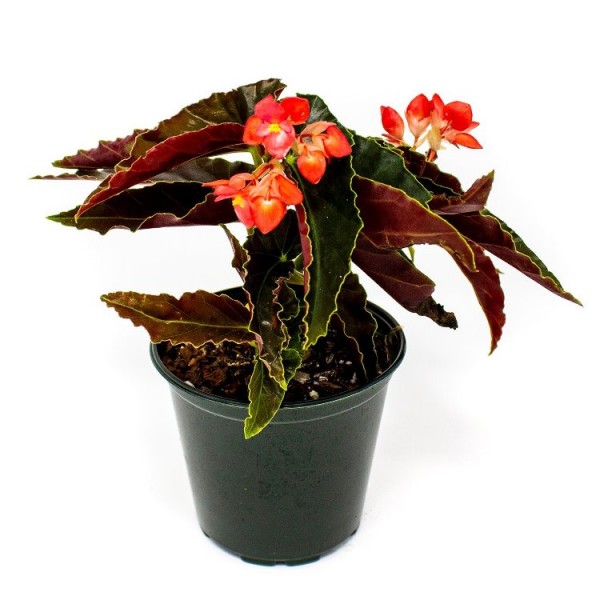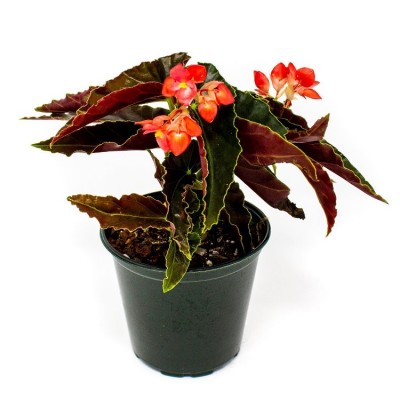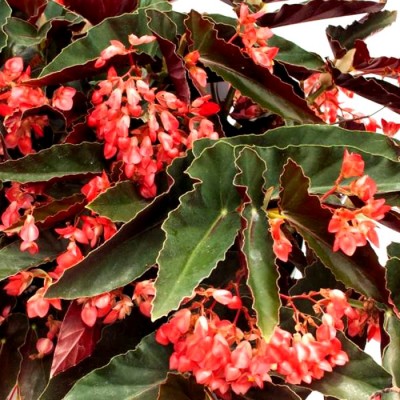This image is for reference purpose only, Photo May Slightly Different From Actual Item in Terms of Color Due to the Lighting During Photo Shooting or the Monitor's Display.
Begonia
Used in containers, hanging baskets and bedding schemes, begonias provide continuous colour throughout the summer until the first frosts. They are easy to care for and all grow well in partial shade.
Cultivation notes
Tuberous begonias are ideally suited to growing in containers and hanging baskets, whilst fibrous rooted begonias make an attractive addition to summer bedding schemes. Begonias for the garden have different cultivation needs so the notes below will help guide you to success. Cultivars which are usually derived from Begonia tuberhybrida are a favourite of gardeners for their bright colours and long flowering season. Male and female flowers are borne separately on the same plant, the male flowers being the showiest. Selections and hybrids of B. boliviensis such as Begonia ‘Million Kisses’ are also available and are excellent free flowering plants for baskets and pots.
- Start tubers into growth in March or April at 18°C (64°F)
- Fill a seed tray 7.5cm (3in) deep with moist sandy potting compost
- Place tubers on the surface of the compost hollow side uppermost 2cm (¾in) apart, 2.5cm (1in) deep
- When the leaves are showing pot into individual 10-12.5cm (4-5in) pots of John Innes No 2 compost or multipurpose compost, including peat-free ones
- Plants can be hardened off and planted outside after the danger of frost has passed
- Feed every week with high potassium feed (e.g. tomato fertiliser) from four-six weeks after their final re-potting until September
- Position in sun or partial shade. In borders ensure the soil is fertile
- Water regularly during dry periods but avoid wetting the foliage
Overwintering
- Tuberous begonias need to be lifted before the first frosts. The leaves will begin to yellow naturally at which time watering should be reduced. The dry tubers should be stored in barely moist soil or sand in a frost-free shed, ideally at 7°C (45°F) and watered occasionally to prevent shrivelling
- The tubers of Begonia ‘Million Kisses’ may be small at the end of the first season but may then over-winter, however most gardeners replace their plants each year
Hardy begonia
Hardy tuberous begonia can be an exotic addition to shady borders particularly in late summer. The most hardy to try is Begonia grandis subsp. evansiana AGM is hardy down to 0°C (32°F).
- Plant tubers 5-7.5cm (2-3in) deep in reasonably fertile well-drained soil and in a sunny, sheltered position
- In mild areas tubers can be left in the ground all year if planted at the base of a warm south-facing wall and mulched to provide winter protection
- Alternatively, start the tubers indoors at 10 °C, pot one tuber to a 10cm (4in) container
- Plant out once danger of frost has passed
- As the leaves turn yellow in autumn dry the tubers and overwinter at a minimum of 2-4°C (35-40°F)
Semperflorens begonia
These fibrous-rooted, tender perennial begonias are usually grown as annuals. Their flowers can be white, pink or red and are produced throughout the summer until the first frosts. The compact plants can also have attractive foliage. They are one of the few bedding plants that are satisfactory in partial shade. Grow from seed or buy young plants.
- Plants can be hardened off and planted outside after the danger of frost has passed
- Feed containers every week with high potassium feed during the summer
- Position in sun or partial shade
- Water regularly during dry periods but avoid wetting the foliage
Pruning and training
If growing tuberous begonias for show the female flowers can be removed but there is no need to do this for garden displays. The stem and foliage can be brittle so support with canes as the plant grows.
Propagation
Tuberous and semperflorens begonias have different growing habits and therefore require different propagation methods.
Begonia Pink Long - Angel Wing Begonia Torch Red
- Live plant along with Plastic pot.
- Plants height with pot is 1 feet and pot size is 5 inch diameter.
- Plants nature is indoor-semi shade, alternate day watering.
- Useful for balcony garden, table top plants, flower beds.
- Seasonal Flowering, grows in monsoon and winter.


